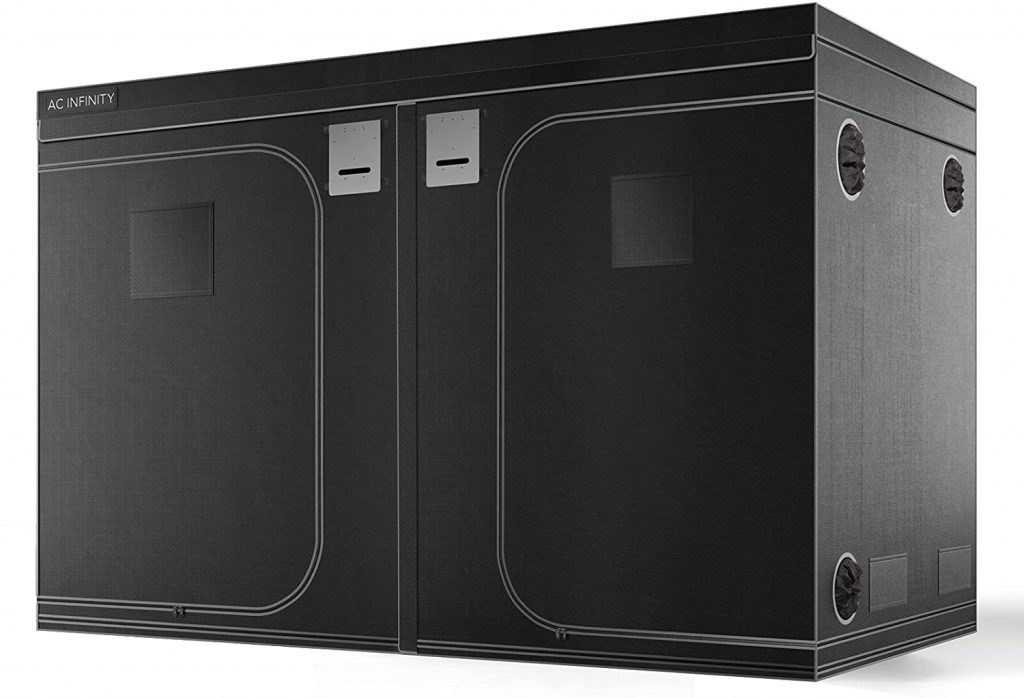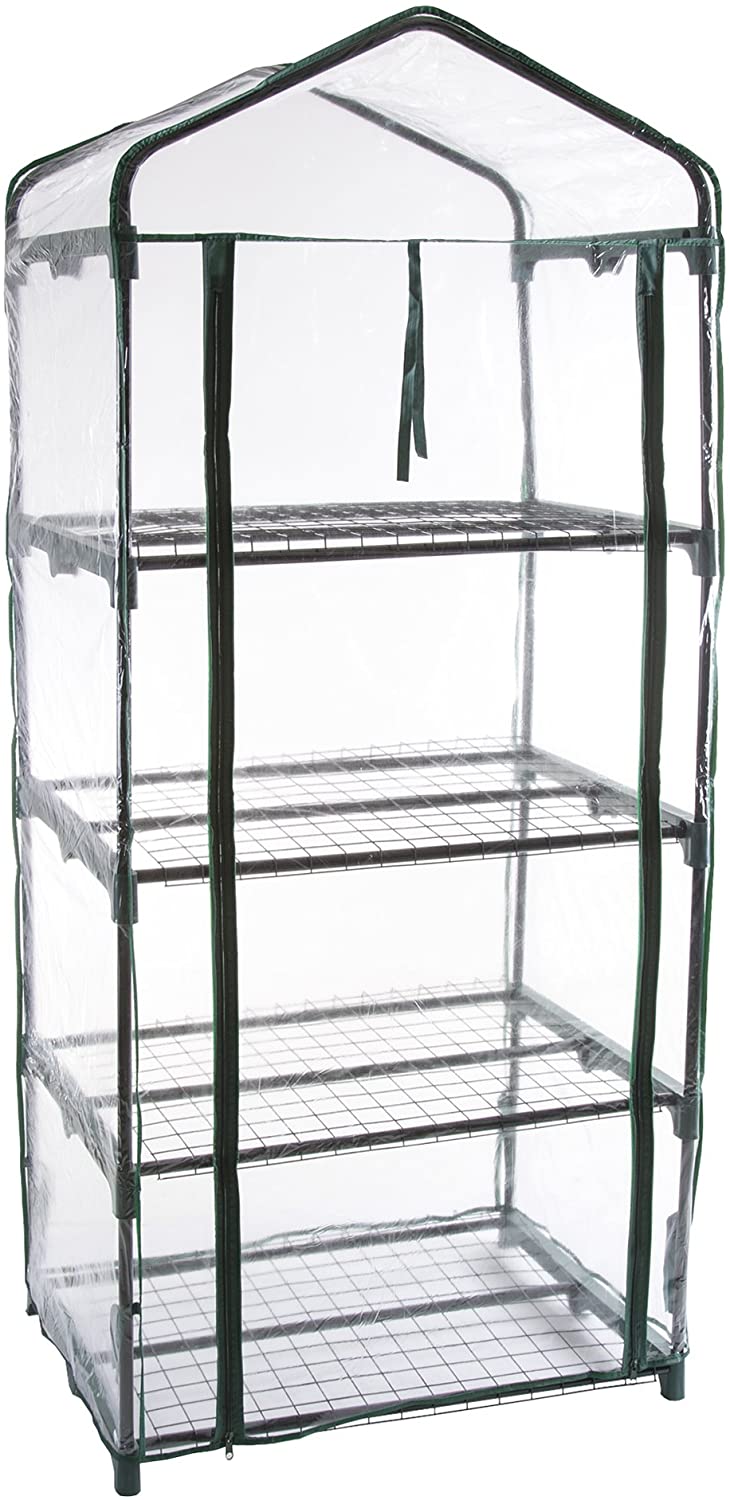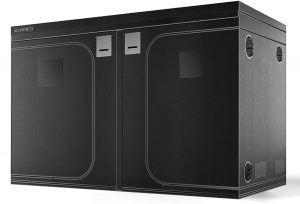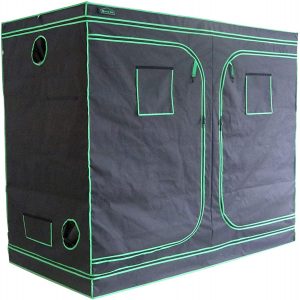A mushroom grow tent[i] is a fruiting chamber for people who need something bigger than a plastic tote but smaller than a dedicated grow room. It’s not meant to be a sterile space—by the time the project is ready to move into a fruiting chamber, the mycelium has already fully colonized its substrate and can resist contamination on its own. Instead, the fruiting chamber is an enclosed space in which the temperature, humidity, and light-level can all be kept where they should be while allowing for adequate fresh air exchange.
It’s worth noting that grow tents are used for many different kinds of mushrooms, some legal to grow pretty much everywhere, some less so. The specifics of the design vary depending on what you want to grow.
It’s also true that getting yourself a mushroom grow tent is not quite as simple as picking out a good model and bringing it home. There’s a degree of DIY involved. Let us explain.
IMAGE | PRODUCT | Header | ||
|---|---|---|---|---|
OUR #1 RATED An advanced grow tent designed to create optimal climate conditions for year-round growing indoors. | ||||
Heavy duty all steel posts, reflective material, light proof, easy assembly. | ||||
Rust resistant frame, small footprint, four tiers, zippers. | ||||
Buying a Mushroom Grow Tent
One thing that stands out, when you peruse grow-tent models, is that these things are generally not marketed for use with mushrooms but with plants—they’re even called “greenhouses,” in many cases. Plants need things fungi don’t (bright light), and fungi need things plants don’t (oxygen). So the brand with the best reviews from plant-growers isn’t necessarily the best for mushroom-growers, and even the most ideal mushroom-growing tents still require significant modification before you can move your fruiting blocks or bags in.
When you buy a grow tent, what you get is the tent and possibly some shelving. That’s not enough. You will also need to obtain, at the very least, a humidifier, and possibly also a heater, hygrometer, thermometer, timer, and lights. If you want to automate the chamber, you’ll need some sort of computer to run the whole thing. If you expect the mushrooms to start releasing spores before you harvest them, you’ll need an exhaust system, too. And you’ll need to modify the tent so that all of the above can connect to it.
The Full Setup (Heater, Ventilation, Lighting, Humidifier)
How you’ll set up your grow tent depends on what kind of tent you get and, to some extent, on what kind of mushrooms you’re growing.
One popular set-up is called a Martha[ii] (apparently it was first made using a product sold by Martha Stewart). It involves a wire frame with four or more shelves covered by a transparent plastic sheath with a door-flap. The shelves allow you to place plenty of cakes or bags inside simultaneously, while the plastic sheath retains both warmth and humidity. There’s just a few complications.
You’ll have to add the humidity, to begin with. Unless you want to spend a lot of time squirting spray bottles, you’ll want to install a humidifier on a timer (too much humidity is also bad). Conceivably, you could put the humidifier inside the tent, but then you wouldn’t have any fresh air exchange, and the humidity levels might differ from the top to the bottom of the tent. Attaching a humidifier to the tent by two different tubes (this means cutting holes in the tent and then ceiling the holes around the tubes to prevent leakage) brings in fresh air with the humidity and ensures even humidity throughout. Some species will require additional fresh air, in which case you can just open the door and fan daily.
All of that moisture will need to go somewhere; it will condense on the walls and drip down. The entire tent needs to sit in a tray that can catch the drips. If the tent has a floor, be prepared for a little water to collect there.
Some Marthas have exhaust hoses. These must vent outside, not into the room, because their whole function is to get rid of spores that would otherwise float around in your living room causing allergies and other problems. The exhaust hose isn’t necessary before spore production begins. For species harvested before spore production starts, it’s not necessary at all.
Fungi need a little light to fruit—that’s how they know where the outside of the substrate is. They don’t want to produce mushrooms inside the middle of the cake where the spores would be wasted, so they look for light. The light doesn’t have to be direct or bright, so because this tent is see-though, you can simply put it in your living-room and take advantage of your windows and room lights. Your living room is probably also close to the fungus’s ideal fruiting temperature, but you may need to use a reptile heat pad to warm it up a bit. Make sure it does not get too warm.
If you don’t want anyone to be able to see your growing mushrooms, you’ll need an opaque tent[iii]. These are available, and have the advantage of including vents so you don’t need to make additional holes. But for some reason these tend not to include shelves, most likely as they are designed to accommodate tall plants, such as tomatoes or perhaps cannabis, as opposed to short mushrooms. You could find a set of shelves to fit inside, or rig a frame from which to hang grow-bags. You could also turn the tent on its side to make it wider than it is tall.
You will still need to rig a humidifier and arrange for fresh air exchange and temperature control. You also need to install lights. These need not be very bright, but do need to be waterproof, given the high humidity involved.
Besides stealth, the point of an opaque grow-tent is to provide absolute control over light level inside—that’s important for some plants, which require precise periods of both bright light and absolute darkness in order to trigger certain growth phases. Most mushrooms do not need that, so light leakage, a major issue for some plant growers, is not so much of an issue.
Here is the optimal full grow tent setup:
Grow Tent: AC Infinity CLOUDLAB 811
FAE (Fresh Air Exchange) Fan: AC Infinity CLOUDLINE T6
Ultrasonic humidifier: Everlasting Comfort Ultrasonic Cool Mist Humidifier
Humidity controller: WILLHI WH1436H 110V Digital Air Humidity Controller
Hose clamps: EesTeck 4″ Duct Clamps
Ducting: Hon&Guan 3 inch 16 FT Long Air Ducting
Fan Filters: USA LGM MERV
How to Use a Mushroom Grow Tent
Using a mushroom grow tent is just like using a shotgun fruiting chamber. It’s just bigger and likely has more automation. Before you begin the grow, you have to make sure that the tent is clean (not sterile, but clean), and that all related equipment is in good working order. Especially, the humidifier must be clean and not, say, growing mold or bacteria inside it as can sometimes happen with enclosed, wet places.
If everything is in good shape then, once your cakes or bags are ready, you can put them in. From there, it’s just a matter of maintaining the right conditions for the variety you’re growing until fruiting—how much monitoring you’ll need to do depends on how automated your set-up is. Depending on what kind of mushroom you’re growing, the air that comes in through the humidifier might not be enough; you may need to fan daily also.
Best Mushroom Grow Tent
The following are ranked from best to worst. Most do get good reviews and have all the features we like. Bear in mind, though, that these are just the tents—they do not come with any related equipment. That’s an entirely different article!
1. AC Infinity CLOUDLAB 811
The Rolls Royce of grow tents, a large, opaque grow tent—it’s almost walk-in closet sized. It has plenty of vents plus viewing windows. Just open the flap to look in and see how things are going. It comes with a tray for catching drips but does not come with shelves. Reviews are generally positive, although the brand does seem to have some issues with shipping, as some customers complain of parts missing or damaged on arrival. The same basic design comes in several sizes, this one being the largest. It’s stealth, it’s big, and its air tight, everything you want as serious grower, buy once, cry once.
You can get the AC Infinity CLOUDLAB 811 here.
2. Green Hut Grow Tent
The Green Hut is much smaller, but still roomier than a plastic tote. It’s also very low-cost, even for its size, an important feature for people who don’t plan to sell their crop. Durable construction offers excellent value for the price. The best value tent.
You can get the Green Hut Grow Tent here.
3. Pure Garden 4-Tier Greenhouse
This one is a transparent mini-greenhouse with four levels of detachable shelving. It’s quite narrow but tall, meaning you can fit a lot of cakes or grow bags into very little floor-floor space. Some customers have had trouble with rust on the shelves, but a coat of spray-paint protects against that. The price is admirably low, a great value. This is the one you want if you are using the Martha method.
You can get the Pure Garden 4-Tier Greenhouse here.
References:
[i] Shields, T. (n.d.). The Fruiting Environment: Choosing a Grow Room Design for Cultivation
[ii] (2020). Mushroom Fruiting Chamber: How to Make a Martha Grow Room. Fungi Academy
[iii] SWEETJUICYWALRUS (2020). My Mushroom Grow Tent Setup Guide!









